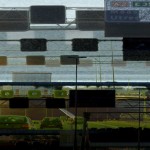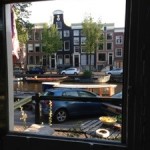'nother labyrinth. I've been fascinated by de Hooch's use of perspective in his paintings of indoor…
De Hooch and Vermeer: meeting of masterpieces

Found a booklet relating de Hooch’s work to that of Vermeer: Meeting of Masterpieces series, Rijksmuseum, 1993. I studied de Hooch’s ‘The Linen Closet’ earlier, and made an installation based on this work, see pic.
De Hooch, in my opinion, is pretty much undervalued. I was glad to come across his work in the core collection of the Rijksumuseum now on show – the Rijks is being renovated, only a few rooms are open to the public and only those works considered very very important are on show.
Looking forward to reading the little book – must do so tomorrow during my train ride to Rotterdam, where I go to teach project management. I’ve been working as a project manager and project management teacher again – nice to pick up my old trade again, but doesn’t leave me much time for art. December/jan/feb promises to be les busy – must take time to read, write and work art stuff! By the way, the blankets in the pic are now being used for experiment no 001
Quote, page 31: “The paintings of De Hooch’s Delft years evoke a world of quiet, domestic contentment, of pleasure taken in the performance of simple household tasks and in the appearance of well-ordered surroundings. It is an art which celebrates simple virtues, the efficient running of the home and the conscientious raising of children. … Despite the apparent simplicity of the De Hooch’s composition, it is in fact very carefully constructed.”
Page 45: “Vermeer’s Little Street, like De Hooch’s painting, presents an intimate segment of town dwellings with a superb illusionists glimpse through an opening. On both canvases the palette is pleasantly light and warm, and given added vitality by a bright red. But with all these similarities, we are also struck by the differences, particularly in the two artists’ handling of the brush. Whereas Pieter de Hooch’s style may be characterised as fairly dry and drawing like, Vermeer has an extremely painterly, pasty technique”
Page 46: “.. any notion that Vermeer might have sat painting en plein air at his easel in the city would be somewhat naive; this practice did not take root until the latter half of the 19th century, under the influence of Realism and Impressionism. It is indeed far from coincidental that Vermeer’s reputation as one of Holland’s greatest painters was established only in the age of Realism. Vermeer became world famous largely thanks to the writings of the French art conoisseur and social democrat Theophile Thore (1806 – 1869)”.
| « Quick and easy Flickr grab | <-- previous post | next post --> | Fun to be with » |
|---|







